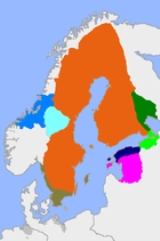
Estonian Swedes
Encyclopedia
The Estonian Swedes, Estonia-Swedes, or Coastal Swedes are a Swedish-speaking linguistic minority traditionally residing in the coastal areas and islands of what is now western and northern Estonia
. The beginning of the continuous settlement of Estonian Swedes in these areas (known as Aiboland) dates back to the 13th and 14th centuries, when their Swedish-speaking ancestors arrived in Estonia from what is now Sweden
and Finland
. Almost all of Estonia's Swedish-speaking minority fled to Sweden during World War II
, and only the descendants of a few individuals who opted to stay are permanently resident in Estonia today.
. Further early mentions of Swedes in Estonia came in 1341 and 1345 (when an Estonian monastery in Padise
sold "the Laoküla Estate" and Suur-Pakri Island to a group of Swedes).
During the 13th through 15th centuries, large numbers of Swedes arrived in coastal Estonia from Finland, which was under Swedish control (and would remain so for hundreds of years), often settling on Church-owned land. The first documented record of the island of Ruhnu
, and of its Swedish population, is also a 1341 letter sent by the Bishop of Courland
which confirmed the islanders' right to reside and manage their property in accordance with Swedish law.
of Swedish Estonia
, which it would hold until 1710 (formally until 1721, when the territory was ceded to Russia under the Treaty of Nystad
). The Estonia-Swedes prospered during this period. Swedish, along with German
and Estonian
, was one of the official languages.
was lost to Russia following the Great Northern War
(1700–1721), conditions worsened for Swedes in Estonia: the lands they had settled were often confiscated from the Church and given to local nobility, and taxes increased. This situation remained the same during Russian rule, and the Estonian Swedes' suffering continued as, for example, the Agrarian reforms which liberated the land of Estonian serfs in 1816, did not apply to Estonian (mostly non-serf) Swedes.
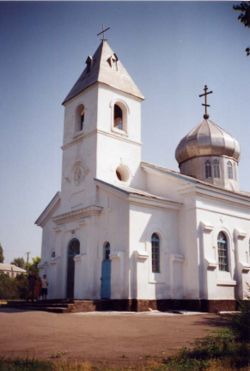 At certain times during Russian Estonia period, groups of Estonian Swedes were forced to leave Estonia for other parts of the Russian Empire
At certain times during Russian Estonia period, groups of Estonian Swedes were forced to leave Estonia for other parts of the Russian Empire
. Most notably, Empress Catherine II of Russia
forced the 1,000 Swedes of Hiiumaa
, to move to Ukraine
in 1781, where they established the community of Gammalsvenskby
.
, the independent Republic of Estonia was created in 1918. The constitution of independent Estonia granted the ethnic minority groups the control over their language of education, the right to form institutions for their national and social rights, the right to use their native language in official capacities where they formed majorities of the population, and the choice of nationality. Swedes, Baltic Germans, Russians
, and Jews
all had ministers in the new national government. Svenska Folkförbundet
, a Swedish political organization, was formed. In 1925, a new law giving more cultural autonomy was passed, although the Russians
and Swedes in Estonia did not take advantage of these new freedoms, mainly for economic reasons.
forced Estonia to sign a treaty concerning military bases. Many of the islands upon which Estonian Swedes lived were confiscated, bases were built on them, and their inhabitants were forced to leave their homes. A year later, Estonia was occupied by, and annexed into, the Soviet Union, and their voice in government was lost. Estonian Swedish men were conscripted into the Red Army
and, during the German occupation
, into the German armed forces
. Most of the remaining Estonian Swedes fled to Sweden prior to the second invasion of Estonia by the Soviet army in 1944. On June 8 1945, there were 6,554 Estonian Swedes and 21,815 ethnic Estonian refugees in Sweden.
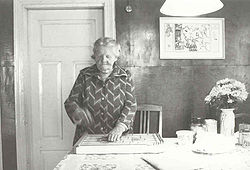 Today, small groups of remaining Estonian Swedes are regrouping and re-establishing their heritage, by studying Swedish language and culture. They are led by the Estonian Swedish Council, which is backed by the Estonian government. In 2000, Swedes were the 21st largest ethnic group in Estonia, numbering only 300. There are however many Estonian Swedes and descendants of Estonian Swedes residing in Sweden.
Today, small groups of remaining Estonian Swedes are regrouping and re-establishing their heritage, by studying Swedish language and culture. They are led by the Estonian Swedish Council, which is backed by the Estonian government. In 2000, Swedes were the 21st largest ethnic group in Estonia, numbering only 300. There are however many Estonian Swedes and descendants of Estonian Swedes residing in Sweden.
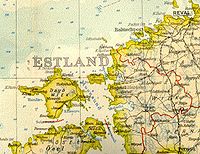 Population figures during the early centuries of Swedish settlement are not available. At the end of the Teutonic period, there were probably around 1,000 Estonian Swedish families, with some 1,500 Swedes in the capital Tallinn
Population figures during the early centuries of Swedish settlement are not available. At the end of the Teutonic period, there were probably around 1,000 Estonian Swedish families, with some 1,500 Swedes in the capital Tallinn
, giving a total population of roughly 5-7 thousand, some 2-3% of the population of what is now Estonia at the time.
The 1897 Russian Census
gives a total Swedish population of 5,768 or 1,39 % in the Governorate of Estonia
. The majority of the Swedes lived in the Hapsal district where they formed a minority of 5,6 %.
The 1922 census gives Estonia a total population of 1,107,059 of which Estonia-Swedes made up only 0.7%, some 7,850 people, who made up majorities in some places, such as Ruhnu
, Vormsi
, Riguldi
. It dropped slightly to 7,641 in 1934. By the time of the Second World War, the population was nearly 10,000, and roughly 9,000 of these people fled to Sweden. Towns with large pre-war Swedish populations include Haapsalu
and Tallinn .
After World War II
the numbers stayed fairly stable: there were 435 Estonian Swedes in 1970, 254 in 1979 and 297 in 1989, when they placed 26th on the list of Estonia's minority groups (before the Second World War, they were third in number, after Russians
and Germans
). The 2000 census
shows a number of 300, placing Swedes at 20th on the list of Estonia's minority groups. However, only 211 of them are Estonian citizens. Since all do not claim their real ethnic background, some have estimated the real number of Estonian Swedes in Estonia to be about 1,000.
 In Ukraine, the village of Gammalsvenskby
In Ukraine, the village of Gammalsvenskby
, founded by Estonian Swedish refugees, had considerable Swedish population until August 1, 1929, when 885 of the villagers fled for Sweden. There are a few hundred people of Estonian Swedish descent in Gammalsvenskby today.
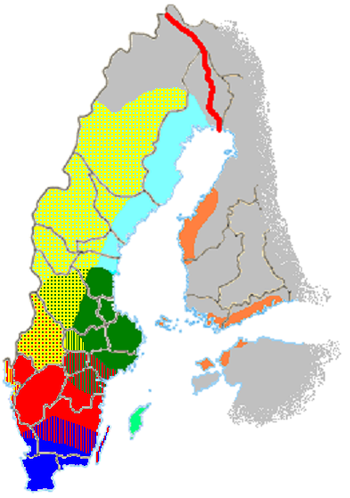 There was not a unified Estonian-Swedish dialect
There was not a unified Estonian-Swedish dialect
, but several. The Estonian-Swedish dialects are subdivisions of the Eastern varieties of Standard Swedish
. Ruhnu
had its own dialect, the Vormsi
-Noarootsi-Riguldi dialect was spoken on those islands, there was also a Pakri-Vihterpalu variety. The dialect of Hiiumaa is still spoken by a few in Gammalsvenskby (which is called Gammölsvänskbi in the Hiiumaa/Gammmalsvenskby dialect).
Estonia
Estonia , officially the Republic of Estonia , is a state in the Baltic region of Northern Europe. It is bordered to the north by the Gulf of Finland, to the west by the Baltic Sea, to the south by Latvia , and to the east by Lake Peipsi and the Russian Federation . Across the Baltic Sea lies...
. The beginning of the continuous settlement of Estonian Swedes in these areas (known as Aiboland) dates back to the 13th and 14th centuries, when their Swedish-speaking ancestors arrived in Estonia from what is now Sweden
Sweden
Sweden , officially the Kingdom of Sweden , is a Nordic country on the Scandinavian Peninsula in Northern Europe. Sweden borders with Norway and Finland and is connected to Denmark by a bridge-tunnel across the Öresund....
and Finland
Finland
Finland , officially the Republic of Finland, is a Nordic country situated in the Fennoscandian region of Northern Europe. It is bordered by Sweden in the west, Norway in the north and Russia in the east, while Estonia lies to its south across the Gulf of Finland.Around 5.4 million people reside...
. Almost all of Estonia's Swedish-speaking minority fled to Sweden during World War II
World War II
World War II, or the Second World War , was a global conflict lasting from 1939 to 1945, involving most of the world's nations—including all of the great powers—eventually forming two opposing military alliances: the Allies and the Axis...
, and only the descendants of a few individuals who opted to stay are permanently resident in Estonia today.
Early history
The Swedish speaking population in Estonia persisted for about 650 years. The first written mention of the Swedish population in Estonia comes from 1294, in the laws of the town of HaapsaluHaapsalu
Haapsalu is a seaside resort town located on the west coast of Estonia. It's the administrative centre of Lääne County and has a population of 11,618 ....
. Further early mentions of Swedes in Estonia came in 1341 and 1345 (when an Estonian monastery in Padise
Padise
-Gallery:...
sold "the Laoküla Estate" and Suur-Pakri Island to a group of Swedes).
During the 13th through 15th centuries, large numbers of Swedes arrived in coastal Estonia from Finland, which was under Swedish control (and would remain so for hundreds of years), often settling on Church-owned land. The first documented record of the island of Ruhnu
Ruhnu
Ruhnu is an island situated in the Gulf of Riga in the Baltic Sea. It belongs to Estonia and is an administrative part of Saare County. At 11.9 km2 it has currently less than 100, mostly ethnic Estonian permanent inhabitants...
, and of its Swedish population, is also a 1341 letter sent by the Bishop of Courland
Courland
Courland is one of the historical and cultural regions of Latvia. The regions of Semigallia and Selonia are sometimes considered as part of Courland.- Geography and climate :...
which confirmed the islanders' right to reside and manage their property in accordance with Swedish law.
Swedish Estonia
In 1561, Sweden established the DominionDominions of Sweden
The Dominions of Sweden or Svenska besittningar were territories that historically came under control of the Swedish Crown, but never became fully integrated with Sweden. This generally meant that they were ruled by Governors-General under the Swedish monarch, but within certain limits retained...
of Swedish Estonia
Swedish Estonia
The Duchy of Estonia , also known as Swedish Estonia, was a dominion of the Swedish Empire from 1561 until 1721, when it was ceded to Russia in the Treaty of Nystad, following its capitulation in the Great Northern War. The dominion arose when the northern parts of present-day Estonia were united...
, which it would hold until 1710 (formally until 1721, when the territory was ceded to Russia under the Treaty of Nystad
Treaty of Nystad
The Treaty of Nystad was the last peace treaty of the Great Northern War. It was concluded between the Tsardom of Russia and Swedish Empire on 30 August / 10 September 1721 in the then Swedish town of Nystad , after Sweden had settled with the other parties in Stockholm and Frederiksborg.During...
). The Estonia-Swedes prospered during this period. Swedish, along with German
German language
German is a West Germanic language, related to and classified alongside English and Dutch. With an estimated 90 – 98 million native speakers, German is one of the world's major languages and is the most widely-spoken first language in the European Union....
and Estonian
Estonian language
Estonian is the official language of Estonia, spoken by about 1.1 million people in Estonia and tens of thousands in various émigré communities...
, was one of the official languages.
Russian rule
After the Teutonic Order lost much of its power in the 16th century and the Dominion of Swedish EstoniaSwedish Estonia
The Duchy of Estonia , also known as Swedish Estonia, was a dominion of the Swedish Empire from 1561 until 1721, when it was ceded to Russia in the Treaty of Nystad, following its capitulation in the Great Northern War. The dominion arose when the northern parts of present-day Estonia were united...
was lost to Russia following the Great Northern War
Great Northern War
The Great Northern War was a conflict in which a coalition led by the Tsardom of Russia successfully contested the supremacy of the Swedish Empire in northern Central Europe and Eastern Europe. The initial leaders of the anti-Swedish alliance were Peter I the Great of Russia, Frederick IV of...
(1700–1721), conditions worsened for Swedes in Estonia: the lands they had settled were often confiscated from the Church and given to local nobility, and taxes increased. This situation remained the same during Russian rule, and the Estonian Swedes' suffering continued as, for example, the Agrarian reforms which liberated the land of Estonian serfs in 1816, did not apply to Estonian (mostly non-serf) Swedes.
Forced emigrations

Russian Empire
The Russian Empire was a state that existed from 1721 until the Russian Revolution of 1917. It was the successor to the Tsardom of Russia and the predecessor of the Soviet Union...
. Most notably, Empress Catherine II of Russia
Catherine II of Russia
Catherine II, also known as Catherine the Great , Empress of Russia, was born in Stettin, Pomerania, Prussia on as Sophie Friederike Auguste von Anhalt-Zerbst-Dornburg...
forced the 1,000 Swedes of Hiiumaa
Hiiumaa
Hiiumaa is the second largest island belonging to Estonia. It is located in the Baltic Sea, north of the island of Saaremaa, a part of the West Estonian archipelago. Its largest town is Kärdla.-Name:...
, to move to Ukraine
Ukraine
Ukraine is a country in Eastern Europe. It has an area of 603,628 km², making it the second largest contiguous country on the European continent, after Russia...
in 1781, where they established the community of Gammalsvenskby
Gammalsvenskby
Verbivka is now part of the village of Zmiyivka in Beryslav Raion of Kherson Oblast, Ukraine which has a Swedish cultural heritage...
.
Conditions improve
The Estonian Swedes' positions improved during the 1850s and 1860s, due to further agrarian reforms, but discrimination remained during the rest of the period of Tsarist rule in Estonia. After the First World War and the Russian RevolutionRussian Revolution of 1917
The Russian Revolution is the collective term for a series of revolutions in Russia in 1917, which destroyed the Tsarist autocracy and led to the creation of the Soviet Union. The Tsar was deposed and replaced by a provisional government in the first revolution of February 1917...
, the independent Republic of Estonia was created in 1918. The constitution of independent Estonia granted the ethnic minority groups the control over their language of education, the right to form institutions for their national and social rights, the right to use their native language in official capacities where they formed majorities of the population, and the choice of nationality. Swedes, Baltic Germans, Russians
History of Russians in Estonia
The population of Russians in Estonia is estimated at 345,000. Most Russians live in Estonia's capital city Tallinn and the major northeastern cities of Narva and Kohtla-Järve...
, and Jews
Jews
The Jews , also known as the Jewish people, are a nation and ethnoreligious group originating in the Israelites or Hebrews of the Ancient Near East. The Jewish ethnicity, nationality, and religion are strongly interrelated, as Judaism is the traditional faith of the Jewish nation...
all had ministers in the new national government. Svenska Folkförbundet
Swedish People's League in the Baltic Sea Provinces
Swedish People's League in the Baltic Sea Provinces was a political party in Estonia, representing interests of the Swedish minority population. The party was founded in 1917. In 1918 it began publishing Kustbon. In March 1919, the party helds its congress....
, a Swedish political organization, was formed. In 1925, a new law giving more cultural autonomy was passed, although the Russians
Russians
The Russian people are an East Slavic ethnic group native to Russia, speaking the Russian language and primarily living in Russia and neighboring countries....
and Swedes in Estonia did not take advantage of these new freedoms, mainly for economic reasons.
World War II
In 1939, the Soviet UnionSoviet Union
The Soviet Union , officially the Union of Soviet Socialist Republics , was a constitutionally socialist state that existed in Eurasia between 1922 and 1991....
forced Estonia to sign a treaty concerning military bases. Many of the islands upon which Estonian Swedes lived were confiscated, bases were built on them, and their inhabitants were forced to leave their homes. A year later, Estonia was occupied by, and annexed into, the Soviet Union, and their voice in government was lost. Estonian Swedish men were conscripted into the Red Army
Red Army
The Workers' and Peasants' Red Army started out as the Soviet Union's revolutionary communist combat groups during the Russian Civil War of 1918-1922. It grew into the national army of the Soviet Union. By the 1930s the Red Army was among the largest armies in history.The "Red Army" name refers to...
and, during the German occupation
Occupation of Estonia by Nazi Germany
After Nazi Germany invaded the Soviet Union on June 22, 1941, Army Group North reached Estonia in July.Initially the Germans were perceived by most Estonians as liberators from the USSR and its repressions, having arrived only a week after the first mass deportations from the Baltics...
, into the German armed forces
Wehrmacht
The Wehrmacht – from , to defend and , the might/power) were the unified armed forces of Nazi Germany from 1935 to 1945. It consisted of the Heer , the Kriegsmarine and the Luftwaffe .-Origin and use of the term:...
. Most of the remaining Estonian Swedes fled to Sweden prior to the second invasion of Estonia by the Soviet army in 1944. On June 8 1945, there were 6,554 Estonian Swedes and 21,815 ethnic Estonian refugees in Sweden.
Today

Areas of population and demographics

Tallinn
Tallinn is the capital and largest city of Estonia. It occupies an area of with a population of 414,940. It is situated on the northern coast of the country, on the banks of the Gulf of Finland, south of Helsinki, east of Stockholm and west of Saint Petersburg. Tallinn's Old Town is in the list...
, giving a total population of roughly 5-7 thousand, some 2-3% of the population of what is now Estonia at the time.
The 1897 Russian Census
Russian Empire Census
The Russian Imperial Census of 1897 was the first and the only census carried out in the Russian Empire . It recorded demographic data as of ....
gives a total Swedish population of 5,768 or 1,39 % in the Governorate of Estonia
Governorate of Estonia
The Governorate of Estonia or Estland, also known as the Government of Estonia or Province of Estonia, was a governorate of the Russian Empire in what is now northern Estonia.-Historical overview:...
. The majority of the Swedes lived in the Hapsal district where they formed a minority of 5,6 %.
The 1922 census gives Estonia a total population of 1,107,059 of which Estonia-Swedes made up only 0.7%, some 7,850 people, who made up majorities in some places, such as Ruhnu
Ruhnu
Ruhnu is an island situated in the Gulf of Riga in the Baltic Sea. It belongs to Estonia and is an administrative part of Saare County. At 11.9 km2 it has currently less than 100, mostly ethnic Estonian permanent inhabitants...
, Vormsi
Vormsi
Estonia's fourth largest island, Vormsi , is located between Hiiumaa and the mainland with a total area of 93 square kilometers. It is part of a rural municipality Vormsi Parish. From mainland, Vormsi is separated by a narrow strait – Voosi Kurk, and from Hiiumaa by a bit wider Hari...
, Riguldi
Riguldi
Riguldi is a village in Noarootsi Parish, Lääne County, in western Estonia....
. It dropped slightly to 7,641 in 1934. By the time of the Second World War, the population was nearly 10,000, and roughly 9,000 of these people fled to Sweden. Towns with large pre-war Swedish populations include Haapsalu
Haapsalu
Haapsalu is a seaside resort town located on the west coast of Estonia. It's the administrative centre of Lääne County and has a population of 11,618 ....
and Tallinn .
After World War II
World War II
World War II, or the Second World War , was a global conflict lasting from 1939 to 1945, involving most of the world's nations—including all of the great powers—eventually forming two opposing military alliances: the Allies and the Axis...
the numbers stayed fairly stable: there were 435 Estonian Swedes in 1970, 254 in 1979 and 297 in 1989, when they placed 26th on the list of Estonia's minority groups (before the Second World War, they were third in number, after Russians
Russians
The Russian people are an East Slavic ethnic group native to Russia, speaking the Russian language and primarily living in Russia and neighboring countries....
and Germans
Germans
The Germans are a Germanic ethnic group native to Central Europe. The English term Germans has referred to the German-speaking population of the Holy Roman Empire since the Late Middle Ages....
). The 2000 census
Census
A census is the procedure of systematically acquiring and recording information about the members of a given population. It is a regularly occurring and official count of a particular population. The term is used mostly in connection with national population and housing censuses; other common...
shows a number of 300, placing Swedes at 20th on the list of Estonia's minority groups. However, only 211 of them are Estonian citizens. Since all do not claim their real ethnic background, some have estimated the real number of Estonian Swedes in Estonia to be about 1,000.
In Ukraine

Gammalsvenskby
Verbivka is now part of the village of Zmiyivka in Beryslav Raion of Kherson Oblast, Ukraine which has a Swedish cultural heritage...
, founded by Estonian Swedish refugees, had considerable Swedish population until August 1, 1929, when 885 of the villagers fled for Sweden. There are a few hundred people of Estonian Swedish descent in Gammalsvenskby today.
Language

Dialect
The term dialect is used in two distinct ways, even by linguists. One usage refers to a variety of a language that is a characteristic of a particular group of the language's speakers. The term is applied most often to regional speech patterns, but a dialect may also be defined by other factors,...
, but several. The Estonian-Swedish dialects are subdivisions of the Eastern varieties of Standard Swedish
Standard Swedish
Standard Swedish denotes Swedish as a spoken and written standard language. While Swedish as a written language is uniform and standardized, the spoken standard may vary considerably from region to region...
. Ruhnu
Ruhnu
Ruhnu is an island situated in the Gulf of Riga in the Baltic Sea. It belongs to Estonia and is an administrative part of Saare County. At 11.9 km2 it has currently less than 100, mostly ethnic Estonian permanent inhabitants...
had its own dialect, the Vormsi
Vormsi
Estonia's fourth largest island, Vormsi , is located between Hiiumaa and the mainland with a total area of 93 square kilometers. It is part of a rural municipality Vormsi Parish. From mainland, Vormsi is separated by a narrow strait – Voosi Kurk, and from Hiiumaa by a bit wider Hari...
-Noarootsi-Riguldi dialect was spoken on those islands, there was also a Pakri-Vihterpalu variety. The dialect of Hiiumaa is still spoken by a few in Gammalsvenskby (which is called Gammölsvänskbi in the Hiiumaa/Gammmalsvenskby dialect).
External links
- Estonian Institute: Estonian Swedes
- Estonian Swedes embrace cultural autonomy rights
- Ethnic Minorities in Estonia
- Gammalsvenskby: the true story of Swedish settlement in Ukraine
- Statistics Estonia: Population by Ethnic Group, Nationality, Mother Tongue, and Citizenship
- Den Andra Stranden -Information project about the Estonian Swedes with history, interactive maps, thousands of pictures, music and personal stories
- Estlandssvenskarna i Estland - har upprättat kulturellt självstyre (In Swedish)

